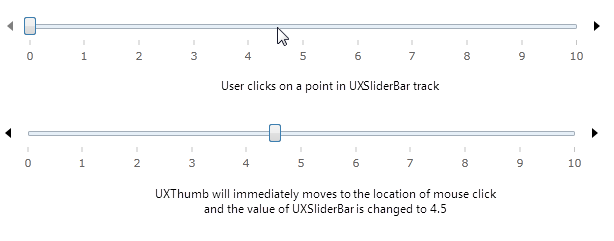

| Intersoft.Client.UI.Aqua.UXInput Namespace > UXSliderBarBase Class : IsMoveToPointEnabled Property |
<CategoryAttribute("Common Properties")> Public Property IsMoveToPointEnabled As Boolean
Dim instance As UXSliderBarBase Dim value As Boolean instance.IsMoveToPointEnabled = value value = instance.IsMoveToPointEnabled
[CategoryAttribute("Common Properties")] public bool IsMoveToPointEnabled {get; set;}
[CategoryAttribute("Common Properties")] public: property bool IsMoveToPointEnabled { bool get(); void set ( bool value); }
By default when you click the decrease and increase button, UXSliderBar will invoke DecreaseLarge and IncreaseLarge command. Alternatively, you can use IsMoveToPointEnabled property to another behavior where UXThumb will immediately moves to the location of the mouse click when you click on the decrease and increase button. The value of UXSliderBar will be changed based on the position of the UXThumb.
| View |
Copy Code
|
|---|---|
<Intersoft:UXSliderBar TickPlacement="BottomRight" HandlesVisibility="Visible" IsMoveToPointEnabled="True" /> |
|

If IsSnapToTickEnabled property is also set to True, the value of UXSliderBar will be adjusted based on the closest tick bar item. In the above sample, if you click on the a position where the value will be set to 4.2, the value of UXSliderBar will be adjusted to the closest tickbar item, which is 4.
Target Platforms: Windows 7, Windows Vista SP1 or later, Windows XP SP3, Windows Server 2008 (Server Core not supported), Windows Server 2008 R2 (Server Core supported with SP1 or later), Windows Server 2003 SP2